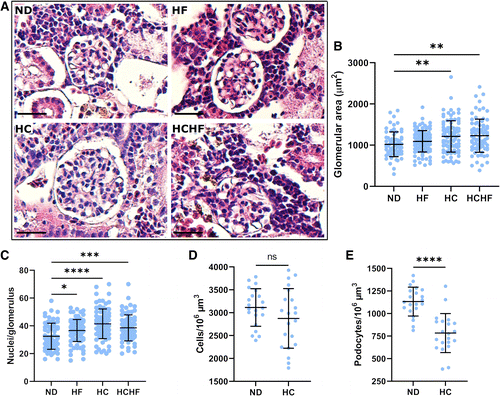Fig. 2
- ID
- ZDB-FIG-220808-64
- Publication
- Zeitler et al., 2022 - High calorie diet results in reversible obesity-related glomerulopathy in adult zebrafish regardless of dietary fat
- Other Figures
- All Figure Page
- Back to All Figure Page
|
Figure 2.High-calorie diet led to glomerulomegaly and decreased podocyte density. A and B: hematoxylin and eosin-stained paraffin kidney sections revealed marked glomerulomegaly in zebrafish fed a high-calorie diet, without evidence of glomerular sclerosis. Kidneys from the high-calorie and high-calorie, high-fat diet-fed groups had significantly larger glomeruli than those in the normal diet-fed group. C: as evaluated by light microscopy, the high-calorie diet-fed group had a higher total cell number in each glomerulus compared with normal diet-fed controls. D: confocal microscopy of kidneys from transgenic fish also showed no difference in total cell density between fish fed a normal diet and fish fed a high-calorie diet. E: in contrast, glomeruli from fish fed a high-calorie diet had lower podocyte density compared with fish fed a normal diet. Scale bars = 25 µm. In B and C, at least 60 glomeruli from 3–4 fish/group were measured on three sections per fish. In D and E, n = 21 glomeruli per group. Data are presented as means ± SD. Statistical tests were as follows: Welch ANOVA with Dunnett’s multiple comparisons test. *P < 0.05, **P < 0.01, ***P < 0.001, and ****P < 0.0001. HC, high-calorie diet; HCHF, high-calorie, high-fat diet; HF, high-fat diet; ND, normal diet. |
| Fish: | |
|---|---|
| Conditions: | |
| Observed In: | |
| Stage: | Adult |

